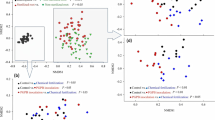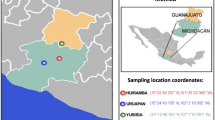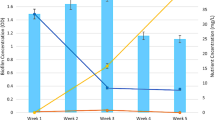Abstract
Phenolic root exudates (PREs) secreted by wetland plants facilitate the accumulation of iron in the rhizosphere, potentially providing the essential active iron required for the generation of enzymes that degrade polycyclic aromatic hydrocarbon, thereby enhancing their biodegradation. However, the underlying mechanisms involved are yet to be elucidated. This study focuses on phenanthrene (PHE), a typical polycyclic aromatic hydrocarbon pollutant, utilizing representative PREs from wetland plants, including p-hydroxybenzoic, p-coumaric, caffeic, and ferulic acids. Using hydroponic experiments, 16S rRNA sequencing, and multiple characterization techniques, we aimed to elucidate the interaction mechanism between the accelerated degradation of PHE and the formation of rhizosphere biofilm/iron plaque influenced by PREs. Although all four types of PREs altered the biofilm composition and promoted the formation of iron plaque on the root surface, only caffeic acid, possessing a similar structure to the intermediate metabolite of PHE (catechol), could accelerate the PHE degradation rate. Caffeic acid, notable for its catechol structure, plays a significant role in enhancing PHE degradation through two main mechanisms: (a) it directly boosts PHE co-metabolism by fostering the growth of PHE-degrading bacteria, specifically Burkholderiaceae, and by facilitating the production of the key metabolic enzyme catechol 1,2-dioxygenase (C12O) and (b) it indirectly supports PHE biodegradation by promoting iron plaque formation on root surfaces, thereby enriching free iron for efficient microbial synthesis of C12O, a crucial factor in PHE decomposition.






Similar content being viewed by others
Data availability
The datasets used and/or analysed in the current study are available from the corresponding author upon reasonable request.
References
A D, Zhang N, Qiu R, et al (2020) Accelerated biodegradation of p-tert-butylphenol in the Phragmites australis rhizosphere by phenolic root exudates. Environ Exp Botany 169:103891. https://doi.org/10.1016/j.envexpbot.2019.103891
Baetz U, Martinoia E (2014) Root exudates: the hidden part of plant defense. Trends Plant Sci 19:90–98. https://doi.org/10.1016/j.tplants.2013.11.006
Batty L (2000) The effect of pH and plaque on the uptake of Cu and Mn in Phragmites australis (Cav.) Trin ex. Steudel Ann Bot 86:647–653. https://doi.org/10.1006/anbo.2000.1191
Burken JG, Schnoor JL (1998) Predictive relationships for uptake of organic contaminants by hybrid poplar trees. Environ Sci Technol 32:3379–3385. https://doi.org/10.1021/es9706817
Chee-Sanford JC, Aminov RI, Krapac IJ et al (2001) Occurrence and diversity of tetracycline resistance genes in lagoons and groundwater underlying two swine production facilities. Appl Environ Microbiol 67:1494–1502. https://doi.org/10.1128/AEM.67.4.1494-1502.2001
Donnelly PK, Hegde RS, Fletcher JS (1994) Growth of PCB-degrading bacteria on compounds from photosynthetic plants. Chemosphere 28:981–988. https://doi.org/10.1016/0045-6535(94)90014-0
Ely CS, Smets BF (2017) Bacteria from wheat and cucurbit plant roots metabolize PAHs and aromatic root exudates: Implications for rhizodegradation. Int J Phytorem 19:877–883. https://doi.org/10.1080/15226514.2017.1303805
Fan Y, Sun S, He S (2023) Iron plaque formation and its effect on key elements cycling in constructed wetlands: functions and outlooks. Water Res 235:119837. https://doi.org/10.1016/j.watres.2023.119837
Fu Y-Q, Yang X-J, Ye Z-H, Shen H (2016) Identification, separation and component analysis of reddish brown and non-reddish brown iron plaque on rice (Oryza sativa) root surface. Plant Soil 402:277–290. https://doi.org/10.1007/s11104-016-2802-8
Guo L, Cutright TJ (2014) Remediation of acid mine drainage (AMD)-contaminated soil by Phragmites australis and rhizosphere bacteria. Environ Sci Pollut Res 21:7350–7360. https://doi.org/10.1007/s11356-014-2642-0
Harbort CJ, Hashimoto M, Inoue H et al (2020) Root-secreted coumarins and the microbiota interact to improve iron nutrition in arabidopsis. Cell Host Microbe 28:825-837.e6. https://doi.org/10.1016/j.chom.2020.09.006
Hothem SD, Marley KA, Larson RA (2003) Photochemistry in Hoagland’s nutrient solution. J Plant Nutr 26:845–854. https://doi.org/10.1081/PLN-120018569
Jin CW, You GY, He YF et al (2007) Iron deficiency-induced secretion of phenolics facilitates the reutilization of root apoplastic iron in red clover. Plant Physiol 144:278–285. https://doi.org/10.1104/pp.107.095794
Juhasz AL, Naidu R (2000) Bioremediation of high molecular weight polycyclic aromatic hydrocarbons: a review of the microbial degradation of benzo[a]pyrene. Int Biodeterior Biodegradation 45:57–88. https://doi.org/10.1016/S0964-8305(00)00052-4
Larsen M, Santner J, Oburger E et al (2015) O2 dynamics in the rhizosphere of young rice plants (Oryza sativa L.) as studied by planar optodes. Plant Soil 390:279–292. https://doi.org/10.1007/s11104-015-2382-z
Lee Y, Lee Y, Jeon CO (2019) Biodegradation of naphthalene, BTEX, and aliphatic hydrocarbons by Paraburkholderia aromaticivorans BN5 isolated from petroleum-contaminated soil. Sci Rep 9:860. https://doi.org/10.1038/s41598-018-36165-x
Leigh MB, Fletcher JS, Fu X, Schmitz FJ (2002) Root turnover: an important source of microbial substrates in rhizosphere remediation of recalcitrant contaminants. Environ Sci Technol 36:1579–1583. https://doi.org/10.1021/es015702i
Li H, Zheng X, Tao L et al (2019) Aeration increases cadmium (Cd) retention by enhancing iron plaque formation and regulating pectin synthesis in the roots of rice (Oryza sativa) seedlings. Rice 12:28. https://doi.org/10.1186/s12284-019-0291-0
López-Vizcaíno R, Alonso J, Cañizares P et al (2014) Electroremediation of a natural soil polluted with phenanthrene in a pilot plant. J Hazard Mater 265:142–150. https://doi.org/10.1016/j.jhazmat.2013.11.048
Mallick S, Chakraborty J, Dutta TK (2011) Role of oxygenases in guiding diverse metabolic pathways in the bacterial degradation of low-molecular-weight polycyclic aromatic hydrocarbons: a review. Crit Rev Microbiol 37:64–90. https://doi.org/10.3109/1040841X.2010.512268
Murakami S, Kodama N, Shinke R, Aoki K (1997) Classification of catechol 1,2-dioxygenase family: sequence analysis of a gene for the catechol 1,2-dioxygenase showing high specificity for methylcatechols from Gram+ aniline-assimilating Rhodococcus erythropolis AN-13. Gene 185:49–54. https://doi.org/10.1016/S0378-1119(96)00629-4
Nakamoto Y, Doyama K, Haruma T et al (2021) Fe, Mn and 238U Accumulations in Phragmites australis naturally growing at the mill tailings pond; iron plaque formation possibly related to root-endophytic bacteria producing siderophores. Minerals 11:1337. https://doi.org/10.3390/min11121337
Nsenga Kumwimba M, Meng F (2019) Roles of ammonia-oxidizing bacteria in improving metabolism and cometabolism of trace organic chemicals in biological wastewater treatment processes: a review. Sci Total Environ 659:419–441. https://doi.org/10.1016/j.scitotenv.2018.12.236
Pérez-Pantoja D, Donoso R, Agulló L et al (2012) Genomic analysis of the potential for aromatic compounds biodegradation in Burkholderiales. Environ Microbiol 14:1091–1117. https://doi.org/10.1111/j.1462-2920.2011.02613.x
Santoyo G, Urtis-Flores CA, Loeza-Lara PD et al (2021) Rhizosphere colonization determinants by plant growth-promoting rhizobacteria (PGPR). Biology 10:475. https://doi.org/10.3390/biology10060475
Schmid NB, Giehl RFH, Doll S et al (2014) Feruloyl-CoA 6′-hydroxylase1-dependent coumarins mediate iron acquisition from alkaline substrates in arabidopsis. Plant Physiol 164:160–172. https://doi.org/10.1104/pp.113.228544
Váradi T, Pap JS, Giorgi M et al (2013) Iron(III) complexes with meridional ligands as functional models of intradiol-cleaving catechol dioxygenases. Inorg Chem 52:1559–1569. https://doi.org/10.1021/ic302378r
Violante A, Barberis E, Pigna M, Boero V (2003) Factors affecting the formation, nature, and properties of iron precipitation products at the soil–root interface. J Plant Nutr 26:1889–1908. https://doi.org/10.1081/PLN-120024252
Vipotnik Z, Michelin M, Tavares T (2021) Development of a packed bed reactor for the removal of aromatic hydrocarbons from soil using laccase/mediator feeding system. Microbiol Res 245:126687. https://doi.org/10.1016/j.micres.2020.126687
Wilhelm RC, Hanson BT, Chandra S, Madsen E (2018) Community dynamics and functional characteristics of naphthalene-degrading populations in contaminated surface sediments and hypoxic/anoxic groundwater. Environ Microbiol 20:3543–3559. https://doi.org/10.1111/1462-2920.14309
Yan Z, Jiang H, Cai H et al (2015) Complex interactions between the macrophyte Acorus calamus and microbial fuel cells during pyrene and benzo[a]pyrene degradation in sediments. Sci Rep 5:10709. https://doi.org/10.1038/srep10709
Zhang N-C, Hong Z-F, Qiu R-L et al (2022) Removal pathway quantification and co-metabolic mechanism evaluation of alkylphenols from synthetic wastewater by phenolic root exudates in the rhizosphere of Phragmites australis. J Hazard Mater 424:127269. https://doi.org/10.1016/j.jhazmat.2021.127269
Zhang N, Dan A, Chao Y et al (2023) Mechanism of polycyclic aromatic hydrocarbons degradation in the rhizosphere of Phragmites australis: organic acid co-metabolism, iron-driven, and microbial response. Environ Pollut 327:121608. https://doi.org/10.1016/j.envpol.2023.121608
Funding
This study was jointly funded by the Technology Project of Guangzhou City, China (202201011783); the Innovation Project of the Science and Technology Conditions Platform at Guangdong Academy of Agricultural Sciences (ZHS2023-05); the Student Innovation Fund of Zhongkai University of Agriculture and Engineering (2023CX29); and the Local Cooperation Project of the China Scholarship Council (202208440274).
Author information
Authors and Affiliations
Contributions
Dan A.: conceptualization, investigation, and writing—original draft, review, and editing. Yifei Zhang: formal analysis, writing—original draft, review, and editing. Hanjie Huang: writing—original draft. Yuan Pan: writing—original draft. Hong J. Di: writing—review and editing. Yunqiang Yi: writing—review and editing. Xiaomeng Zhang: writing—review and editing. Jiewen Yang: resources and supervision. All authors read and approved the final manuscript.
Corresponding author
Ethics declarations
Ethical approval
Not applicable.
Consent to participate
Not applicable.
Consent to publish
Not applicable.
Competing interest
The authors declare no competing interests.
Additional information
Responsible Editor: Diane Purchase
Publisher's Note
Springer Nature remains neutral with regard to jurisdictional claims in published maps and institutional affiliations.
Dan A. and Yifei Zhang are co-first authors.
Rights and permissions
Springer Nature or its licensor (e.g. a society or other partner) holds exclusive rights to this article under a publishing agreement with the author(s) or other rightsholder(s); author self-archiving of the accepted manuscript version of this article is solely governed by the terms of such publishing agreement and applicable law.
About this article
Cite this article
A, D., Zhang, Y., Huang, H. et al. Unraveling the mechanism of interaction: accelerated phenanthrene degradation and rhizosphere biofilm/iron plaque formation influenced by phenolic root exudates. Environ Sci Pollut Res 31, 35853–35863 (2024). https://doi.org/10.1007/s11356-024-33349-z
Received:
Accepted:
Published:
Issue Date:
DOI: https://doi.org/10.1007/s11356-024-33349-z




